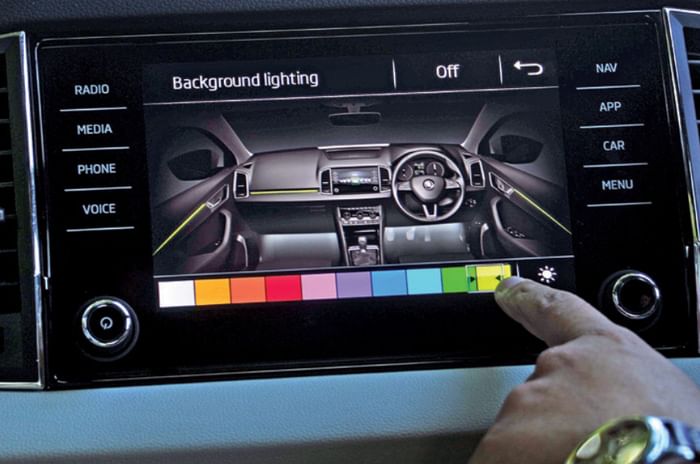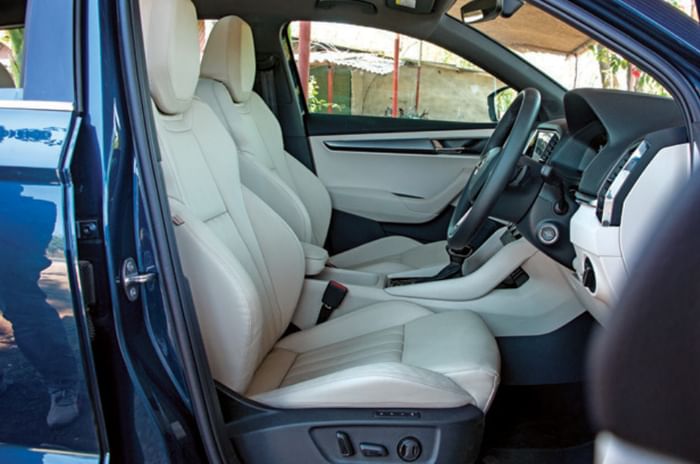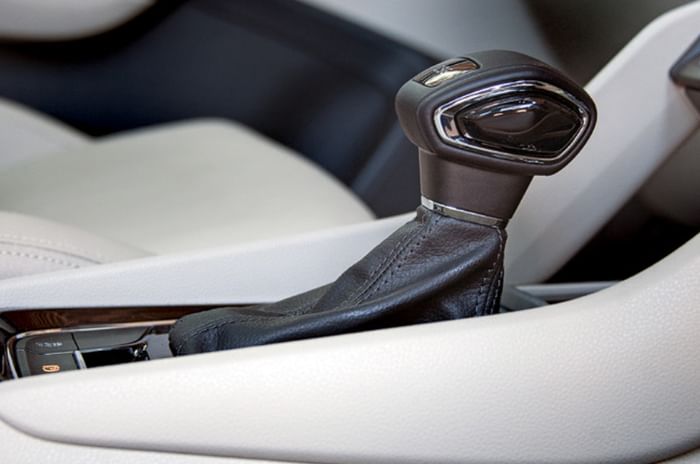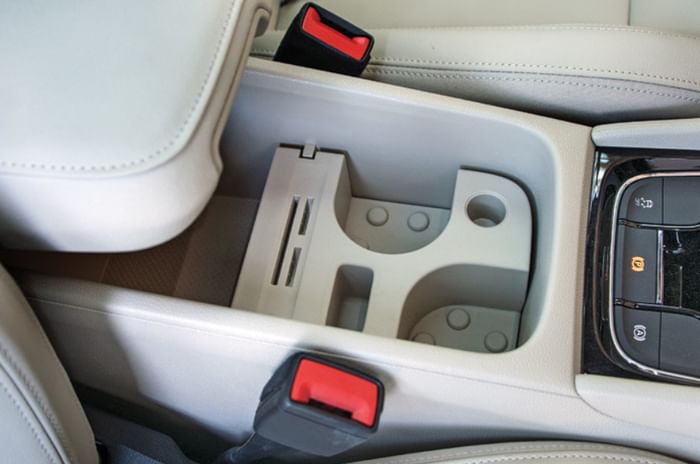Skoda’s Yeti, you either loved it or you just didn’t get it. Downright quirky in some places, brilliant in others, and specifically designed to stand out from the crowd, the Yeti polarised opinion, right down the middle. Me? I just loved it. The nose, with its rally car-like spot lamp integrated into the bumper, looked cool; I loved the casual manner in which the Yeti felt at home on broken roads, and then there was the fact that it had a massive affinity for corners. It wasn’t well suited to being chauffeur-driven around in, it didn’t come with an automatic gearbox – a deal breaker for many – and then there was the fact that all other SUVs in its class were a bit bigger. So it lacked mass appeal.

This is primarily why, when it came to the Karoq – its replacement, if not its spiritual successor – Skoda decided to follow the straight and narrow. Quirkiness isn’t listed high in its list of must-have traits when it comes to designing and, more importantly, selling a mass market car in large numbers. So the Karoq, as a result, is an SUV that feels as straight-laced and controversy-free as they come.
Three-piece suit, with hiking boots
Now while it may be short on shock value, Skoda’s baby Kodiaq is not short on charm. Sure, the design isn’t in your face, and for ‘bling’, the Karoq is probably dead last. But is it devoid of character? No way. It has an easy-going and relaxed appeal that only gets stronger the more you look at the car. And then there’s a balance to the design that’s rare. Even the proportions are just perfect. Viewed side on, the nose is just the right size. I love the manner in which the large squared wheel arches add muscle, how the gently tapering glass house works well, and that the roof fits nice and sung.

Skoda’s origami-like cuts and creases around the nose and tail also add loads of character. Working alongside the crystalline headlights and tail-lights, they make for an interesting interplay between light and shade. And, around the front, those tiny secondary lamps that give it a high-cheekbone look are nicely done. Interestingly, there’s no winged arrow logo at the rear, just ‘Skoda’ spelt nice and large.
Though the Karoq will initially be imported, and it will be expensive for its size and class Skoda has the option of assembling it here later. What makes this possible is that the SUV, like the majority of Skoda and VW cars today, is built on VW’s flexible MQB platform. This means it gets a robust and tough floorpan, a sophisticated steering system, and a very stiff chassis that’s good for ride and handling, and, of course, safety. This car, however, doesn’t have four-wheel drive, and as a result, like the lower-spec Octavias, gets only a non-independent rear suspension. Skoda would say it’s simply clever; but is it?

Just about the right size
Simply clever is also what comes to mind when you look inside the boot of the Karoq. There’s stuff here you don’t find anywhere else, all of which are genuinely useful. There’s the magnet-equipped, rechargeable LED torch, there are Velcro-coated angled brackets you can fix on the boot floor to prevent luggage from flying around, and another nice touch is that Skoda has kept the link to Yeti, by providing the same boot rails and sliding hooks. Just love the way you can turn the hooks down and lock them in place where ever you want. Boot space, at 521 litres, is also plenty, and then there’s the fact that the rear seats can be folded if you need more space.
With its substantial 2.6m-long wheelbase, space in the rear of the cabin is also good. For the record, the Karoq is 4,382mm long, which makes it a lot larger than the recently launched VW T-Roc at 4,234mm. The backrest is a bit upright, but, apart from that, seat height is good, as is thigh support. What’s nice is that you don’t feel hemmed in at the rear, and this is partly due to the massive sunroof. It is worth noting that the Karoq is wider than even the Tiguan Allspace.

The place to be in the Karoq, however, is up front. It’s here that the tough build of the Skoda and its quality of materials really shine. Again, the design of the dash won’t grab your attention but the more time you spend with the Karoq, the more you get what it’s all about. Everything you touch, for example, is superbly built, almost all the materials have a premium feel, and Skoda designers have added to the appeal of the cabin by lining all that’s important with plenty of high-quality chrome. There’s some around the vents, the centre console mixes piano black and chrome superbly, and the highlights carry on across to the steering wheel and doorpads as well.

Also impressive is the tough build of the dash, and the manner in which the soft black top spills onto the lighter coloured lower bit is special. I particularly like the grab handles that are built into the centre console, and I think the high-quality, slick touchscreen and digital instrument panel go superbly together. In fact, the functionality of the screen is outstanding. The display is crisp, it responds instantly, and the software is so intuitive, you rarely have to second guess. And with mood lighting that can be customised to suit your taste, the cabin gets a lift too.
The only bit that sort of seems out of place is the plain-looking gear selector.
I’ve left the best bit for last. With the extra bolstering, perfect cushioning, and ample lateral support, the front seats are just exceptional. So comfy, you can spend hours in them and step out as fresh as a daisy.

Neat, tidy and entertaining
With a 150hp TSI petrol under the hood and a 7-speed twin-clutch automatic, the Karoq is easy to drive at a relaxed pace. Unlike some of the TSI petrols that love to spin fast, this long-stroke engine is tuned more for torque. Happiest when driven between 2,000 and 4,500rpm, the engine has plenty of urge and pulling power, even if all you use is half-throttle. And while the engine is clearly turbocharged, the boost comes in so smoothly, you need to pay attention to identify the transition point. This makes it well-suited for urban traffic. And what also fits nicely here is the twin-clutch gearbox. Yes, at times, the DSG does pause inordinately when the engine is at low speed, and, at times, it shifts abruptly. However, all things considered, the Karoq feels right at home in the city, with more than enough grunt to overtake slower traffic easily.
Winding the engine harder, all the way to the redline, delivers stronger thrust, and then the Karoq feels quick. Driven flat out against the clock, the SUV takes 10.03sec to reach 100, and hold onto the pedal for 25.16sec and you’ll be doing 160kph. This, however, isn’t among the best TSI engines, especially at high speed. It feels strained past 4,500rpm, and it gets a bit boomy near the redline too. So, unless you really want to extract max performance, it’s best driven in a more relaxed manner.

Skoda’s suspension settings always seem to work well in India. And it’s no different here. The ride quality is particularly impressive. The roads here in Pawna are a patchwork of very good, not so good and downright poor, but the Karoq simply rolls over them, silently, smoothly, and without too much movement of the cabin. There’s a suppleness you seldom find in an SUV of this size and class, and what adds to the calm is that the Karoq is nicely insulated from the outside world.
It is also nice and light to drive in the city. The steering is fluid, smooth, and easy to twirl, you can tap the gear lever into ‘Drive’ with a deft flick of your left hand, and since pedal effort is also beautifully calibrated, even a whole day behind the wheel of the Karoq is unlikely to tire you out.
The Karoq is entertaining to drive as well. It dives into corners with enthusiasm, the steering is direct and quick, and since there is more than a bit of feel and feedback, driving it on a winding road can be entertaining. What plays a contributing role is that, at medium speeds, it is nice and composed. Drive harder, however, and the Karoq soon runs out of grip, especially at the front. Body roll increases, and the once neat and tidy dynamics slowly begin to unravel.

Worth the stretch?
Comfortable on the inside, well built, and nice to drive, Skoda’s Karoq is an SUV that clearly ticks a lot of boxes. The nicely built interior is full of quality materials, the driver’s seats are very comfortable, the engine, gearbox and steering make driving it effortless, and it even rides superbly. Yes, it is missing kit like wireless charging and cooled seats, a bit more space in the rear would have been nice, and since it’s an import expected to be priced around Rs 24 lakh, it isn’t exactly cheap. Still, if you are looking for a more affordable, more fun-to-drive Kodiaq, without the rear seats that is, this is exactly what the doctor ordered.













































